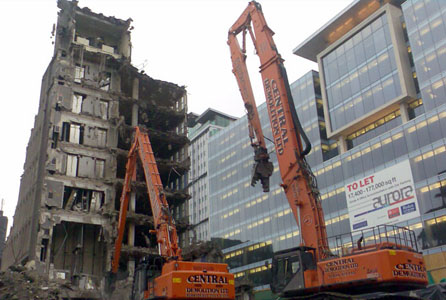
High Reach Demolition
If explosive charges and wrecking balls aren’t the preferred means of demolition, deconstruction is the best alternative. Unfortunately, it’s extremely difficult to get the necessary demo equipment up twenty, thirty or forty stories when dealing with skyscrapers. To properly address this issue, special equipment has been designed to accommodate high reach demolition. Giant hydraulic towers of steel affixed to what looks like a crane-base mount have shears attached to the end of their “arm” that can reach upwards of several hundred feet. Video equipment allows the operator to see the end of the arm and the surrounding area. By remotely controlling the arm and the pincers of the machine, it’s possible to deconstruct a building starting at the top floor while remaining safely poised inside of an operator’s terminal on the ground.
Toppling Skyscrapers
Skyscrapers are full of useful material that can be sold at a profit if it is properly sorted during the demolition process. Without the use of a high reach demolition machine, only a few options are left.
- Floor-by-floor demolition: a team basically goes to the top story of the skyscraper and begins demolishing the building using hand-operated power tools. This process can take months to complete and is extremely costly.
- Explosive demolition: This is the most commonly used method of demolition and it involves placing TNT in critical weak points of a structure’s frame. Computer software is used to create three dimensional images of the building and by using real physics engines, the outcome of explosives placement can be determined through a virtual “trial and error” process.
- Wrecking ball demolition: This is a crude method of demolition that doesn’t take as long as the floor-by-floor method but isn’t nearly as quick as the explosive method.
Of these other three kinds of demolition, only floor-by-floor demolition allows for deconstruction and processing/ sorting of materials for re-sale effectively. Explosions and wrecking balls created mixed debris that must be sorted, (which takes a long time) if the material is going to be resold.
Controlled Explosive Demolition – Quick but Costly
While demolition via explosives is the most popular form of demolition, it can wind up creating more work and costing more than by using a high reach demolition machine when dealing with very large, tall buildings. Because of the sheer volume of material that a skyscraper is made of, there is a lot of potential to recover costs spent on demolition by selling scrap metal. Steel I-beams can be melt down and reused if they’re sorted during demolition using a high reach machine.
Taller Structures, More Waste: Large Dumpster Sizes for Waste
Naturally with demolition of skyscrapers, there’s going to be a lot of unusable waste that can’t be recycled or resold. Examples include:
- Drywall scraps
- Ductwork/ HVAC systems
- Mangled plastic material
- Asbestos containing materials
To properly dispose of the tens to hundreds of thousands of pounds of waste material, demolition dumpster trailers are used. High reach demolition machines can sort materials in these dumpsters while the demolition is underway.
